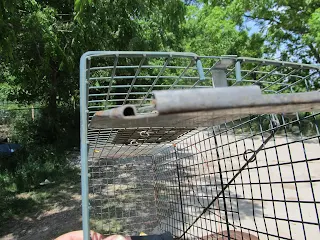You can catch varmints that are eating your garden.
You can catch varmints that get into your trash.
You can catch squirrels, rabbits, woodchucks and so on for personal consumption.
If you have an accidental catch like a neighbor's cat or small dog then you can let it go.
They are handy but some of the most common ones benefit from a few tweaks to improve them.
Increasing headroom
One problem with this particular style of trap is that the door droops down. Big old Mr Raccoon or Mr Woodchuck can bump the door with their back on the way in. The trigger disengages when their back lifts the door. If the weight of the door or the motion of the trigger rod spooks them they can easily escape because the door never closed enough to engage the lock.
 |
| If you sight down the rolled edge of the door you can see that it is kinked upward in the middle. |
 |
| If you sight down the rolled edge now you will see that the middle is now kinked downward. |
 |
| That looks much better. I probably gained 2" of head room. |
The trap originally had two of these split, support rings holding the rod between the tread plate and the trigger. After catching a few animals one of them rotated around and no longer retained to the wire mesh of the cage.
It was little loss. There is a better way.
 |
| It is called an instantaneous center because at the precise moment in time every molecule of the rigid trigger rod is rotating around that axis. |
 |
| Ya, it really works. It binds less than the rings, too. |







No comments:
Post a Comment
Readers who are willing to comment make this a better blog. Civil dialog is a valuable thing.